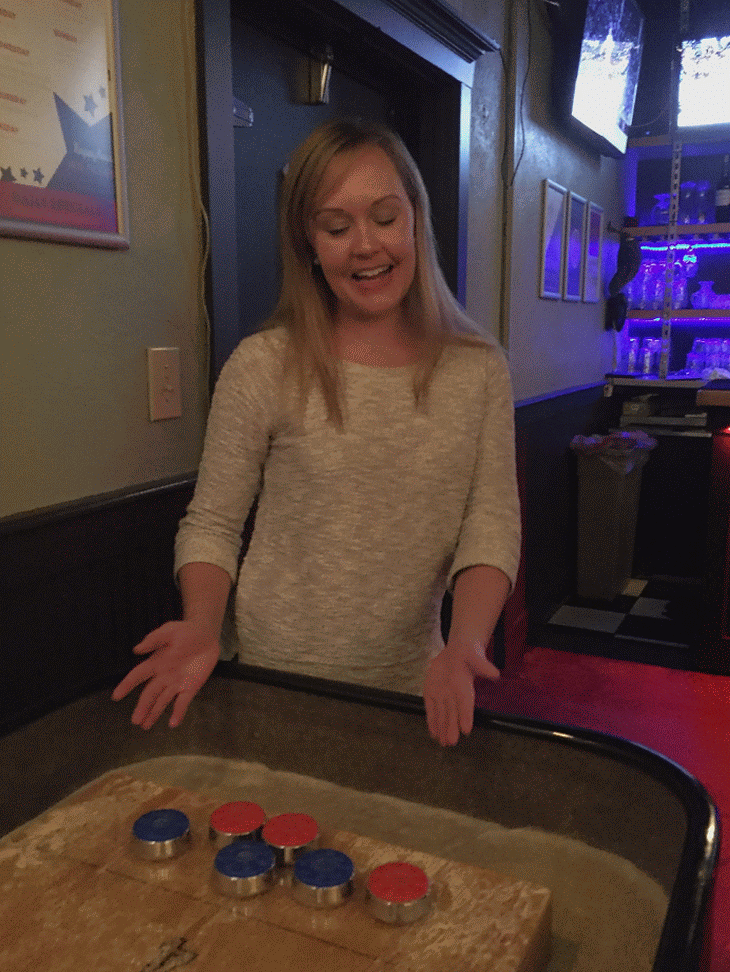How to Play Table Shuffleboard
Updated May 20, 2018
An official shuffleboard table is 20 inches wide by 20 feet and 8 inches long. The pucks slid down the table are called weights, and the official tournament size of a weight is 2.3125 inches wide by 0.75 inches tall (with an allowable margin of 0.05), weighing 310 - 355 grams without a cap.
But weight, there's more!
Whether you're playing in a shuffleboard league, tournament, or casual game, knowing how to play will make the experience more fun.
Game Structure
Table shuffleboard is usually played in a singles or doubles format like tennis. Before any game, players typically have a coin toss to determine who goes first, the loser of the toss may choose the color of their weights or the side they shoot from. In singles games, both individuals will shoot from the same side and rotate the end of the table that they shoot from after each frame.
Start Small
In shuffleboard, each round of play is called a frame, similar to bowling. Players alternate sliding their pucks down the table until all pucks have been played. Players play as many frames as it takes until one player wins. Leagues and tournaments typically play to either 15 or 21 points, and winning by 2 points isn't required.
How to Play
There are two methods of scoring, similar to cornhole/bags. Cumulative scoring means every point scored counts toward a team's overall score. Cancellation scoring, which is more typical, means only one team scores per frame. The puck in the best position - closest to or hanging over the end of the table - is the scoring puck. Any other pucks on the same team as the scoring puck also score, up until the competing team has a puck of a similar point value. For example, if team A has 2 pucks in the 2 point zone and team B doesn't have any pucks on the table, team A scores 4 points. If team B instead had a puck in the 2 point zone that was closer to the end of the table than one of team A's pucks, then team A would only score 2 points. A simplified version of cancellation scoring is to allow all weights in scoring zones to count toward a team's score, and subtract the lower scoring team's score from the higher teams score each frame and add it to the total score.
Or Go Big!
Shooting Tips
All weights are kept in the table gutter, aka trough, until it's time to shoot them. Players alternate pucks until all pucks have been played. Every shot must fully pass the mid line, if they do not, the puck should be removed from the table and put in the trough. It's important to wait for the previous player's shot to stop moving before taking your turn, but it's also expected that you'll take your turn within 30 seconds. Some bars will have a shooting foul line for your feet and some will not. If there is a foul line, you should start with both feet behind the foul line, and keep at least one foot behind the foul line when you take your shot. If there isn't a foot foul line just try not to lean too hard on the table. Leaning on a shuffleboard table may make it easier to shoot, but could effect the level of the table.
There are multiple types of shots in shuffleboard:
Free Shot
A free shot is not free booze. It's the most basic form of a table shuffleboard shot, where one slides the puck freely down the center of the table with no intended spin.
Hanger
A hanger shot is the best possible shot in shuffleboard because it scores the most points. A hanger hangs off the far end of the table without falling off.
Go Around
The go around shot is a more skilled shot requiring English, or spin, on the puck to make it curl around other pucks.
Bump Shot
Similar to volleyball, a bump is something used to assist your own team. A bump shot is when you aim at your own puck with the goal of moving it toward a better scoring position.
Knock Off
Nope, it's not a fake pair of sunglasses or a handbag you bought from someone's trunk. in shuffleboard, a knock off shot is a defensive shot where you knock an opponent's puck off the table (when all goes as planned).
Guard Shot
The guard shot is another defensive move where you place your puck in a way that protects your other puck(s) in a better scoring position from being knocked off.
Stick Shot
When you hit an opponent's puck and leave your puck where it left, you've nailed a stick shot.
If the puck somehow gets turned upside down it should be carefully flipped over and placed in the same position.
Scoring
Shuffleboard tables usually have a foul line that shows the minimum distance a puck has to travel, and scoring zones to note how many points a puck landing in that zone scores. Some tables have 3 point zones and some have 5. A Hanger is a puck that is hanging off of the end of the table, and if your league or shuffleboard tournament allows hangers, they are usually worth more than the maximum point zone on the table because they're the hardest shot to land!
Where to Play Shuffleboard
Head to our shuffleboard page to find shuffleboard bars, leagues and tournaments near you.






